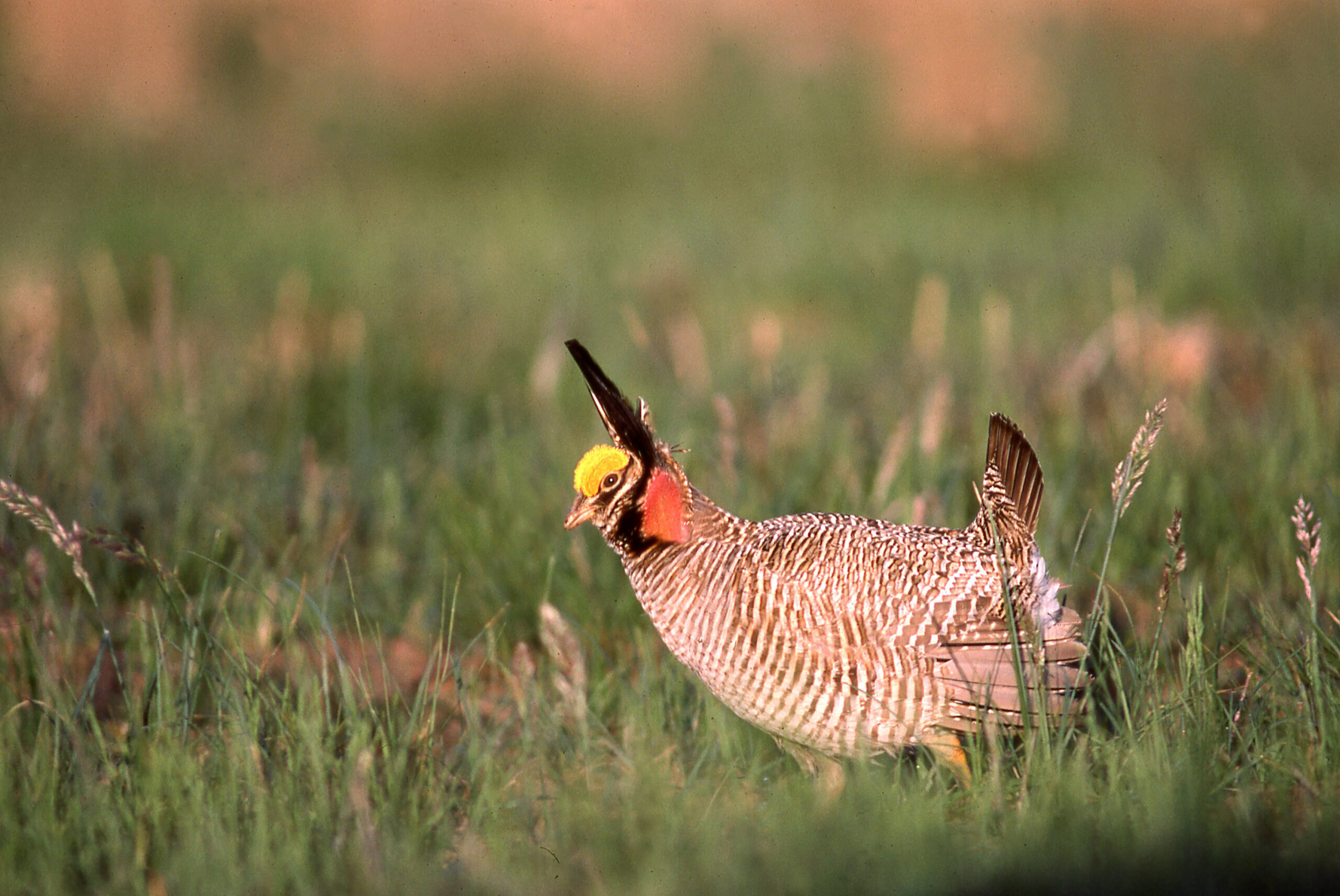
A male lesser prairie chicken displaying on a breeding ground in southern Kansas. Photo by Chris Madson, copyright 2014, all rights reserved.
AS WE WATCH WHAT COULD BE THE BEGINNING OF THE END OF THE WORLD’S OLDEST DEMOCRATIC REPUBLIC, I HESITATE TO raise issues that seem clearly subordinate. But, for those of you who care about the American relationship with wildlife and wild land, I thought the impact of the last month’s executive orders on a specific conservation effort might be of interest.
The decline of the lesser prairie chicken on America’s southern great plains over the last century has been catastrophic. More than 90 percent of its original prairie habitat has been destroyed, and much of the habitat the birds still occupy is degraded. For that reason, in 2023, the U.S. Fish and Wildlife Service classified the lesser chicken as “threatened” under federal law in the northern part of its range and “endangered” in the southern part.
Any effort to maintain the birds that are left, let alone an approach that would allow the population to grow, is complicated by the fact that the species lives almost entirely on privately held land. Efforts by the federal government and the Western Association of Fish and Wildlife Agencies to help lesser chickens have met with little success.
Enter the North American Grouse Partnership, a small group of wildlife biologists and landowners with deep experience in conservation work in farm and ranch country. The partnership has sought out landholders who were interested in helping the lesser chicken and asked them what help landowners needed to provide for the species on their property. Not surprisingly, the ranchers were worried that an aggressive effort to improve prairie habitat for the chickens was likely to reduce their income. Was it possible, they asked, for someone to reimburse them for at least some of that loss?
Ted Koch, executive director, and members of the board of directors and staff thought funding from the conservation title of the federal Farm Bill might do just that. They discussed the possibility with the state offices of the Natural Resources Conservation Service in the region, the offices in charge of the Farm Bill, and generated support for the approach. With that groundwork laid, they approached the National Fish and Wildlife Foundation with a grant proposal. Give us the funding for a full-time person to coordinate this effort, they said, and we will connect landowners with the help they need to provide for the native grouse.
Last year, the Fish and Wildlife Foundation approved the grant, and the Grouse Partnership set about hiring a person to make the connection that would help landowners help lesser prairie chickens. There was a lot of quiet enthusiasm about the new approach from federal wildlife authorities and NRCS staff, from knowledgeable conservationists in the private sector, and from a growing number of landowners. One veteran of the conservation movement said this program could well be the template for programs intended to support rare wildlife on many other working landscapes. Late in 2024, the Grouse Partnership hired a person to serve as lesser prairie chicken coordinator.
And, about two weeks ago, the Grouse Partnership heard that all funding from the National Fish and Wildlife Foundation was frozen indefinitely, which meant that the new prairie chicken coordinator would have to be paid from some other source, not yet identified, or let go. The blanket reduction in force the administration has ordered across most federal agencies is still percolating down through the U.S. Department of Agriculture, but there’s a good chance that staffs in NRCS offices across the country will be reduced, even slashed, which will drastically complicate any effort to use conservation funding from the Farm Bill to help lesser prairie chickens or any other wildlife.
What remains to be seen is whether the two immense federal conservation laws involved in the plan to save the lesser chicken— the conservation title of the Farm Bill and the Endangered Species Act— will themselves survive the attentions of the current administration. Both have been controversial, and the listing of the lesser prairie chicken, in particular, was met with intense opposition in some quarters when it was announced. Whether either law is funded, enforced, gutted, or simply erased is likely to depend on the number of voices raised for or against them.
As is so often the case with rare species, the lesser prairie chicken is just one component of an ecosystem under siege. As a group, grassland birds have been in steep decline over the last fifty years. An effective strategy to recover lesser chickens would benefit a host of other wildlife, and the plan the Grouse Partnership has assembled would benefit many landowners as well. But, like so many other worthy programs that depend on federal funding, this one is on indefinite hold.
I hope the funds from the National Fish and Wildlife Foundation begin to flow again. I hope the Natural Resources Conservation Service has the staff and budget to continue, even expand, its vital conservation work. I hope the conservation title of the federal Farm Bill is expanded and adequately funded to help the lesser prairie chicken and other wildlife on other landscapes. I hope we continue to acknowledge the dire condition of native landscapes on the southern plains and elsewhere and look for ways to care for the grasslands that remain. I hope all those things will come to pass, but I doubt any of them will happen without vigorous public support.
In 1775, Tom Paine observed that “those who expect to reap the blessings of freedom must, like men, undergo the fatigue of supporting it.” As citizens, we have work to do.
I note that the views I’ve expressed here are my own and do not necessarily reflect the positions of the North American Grouse Partnership or any other organization or government entity.
Leave a Reply
You must be logged in to post a comment.